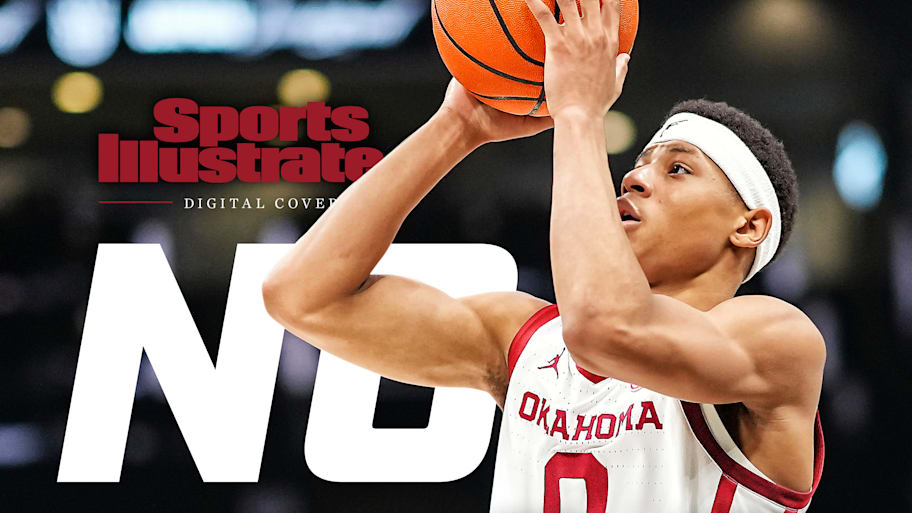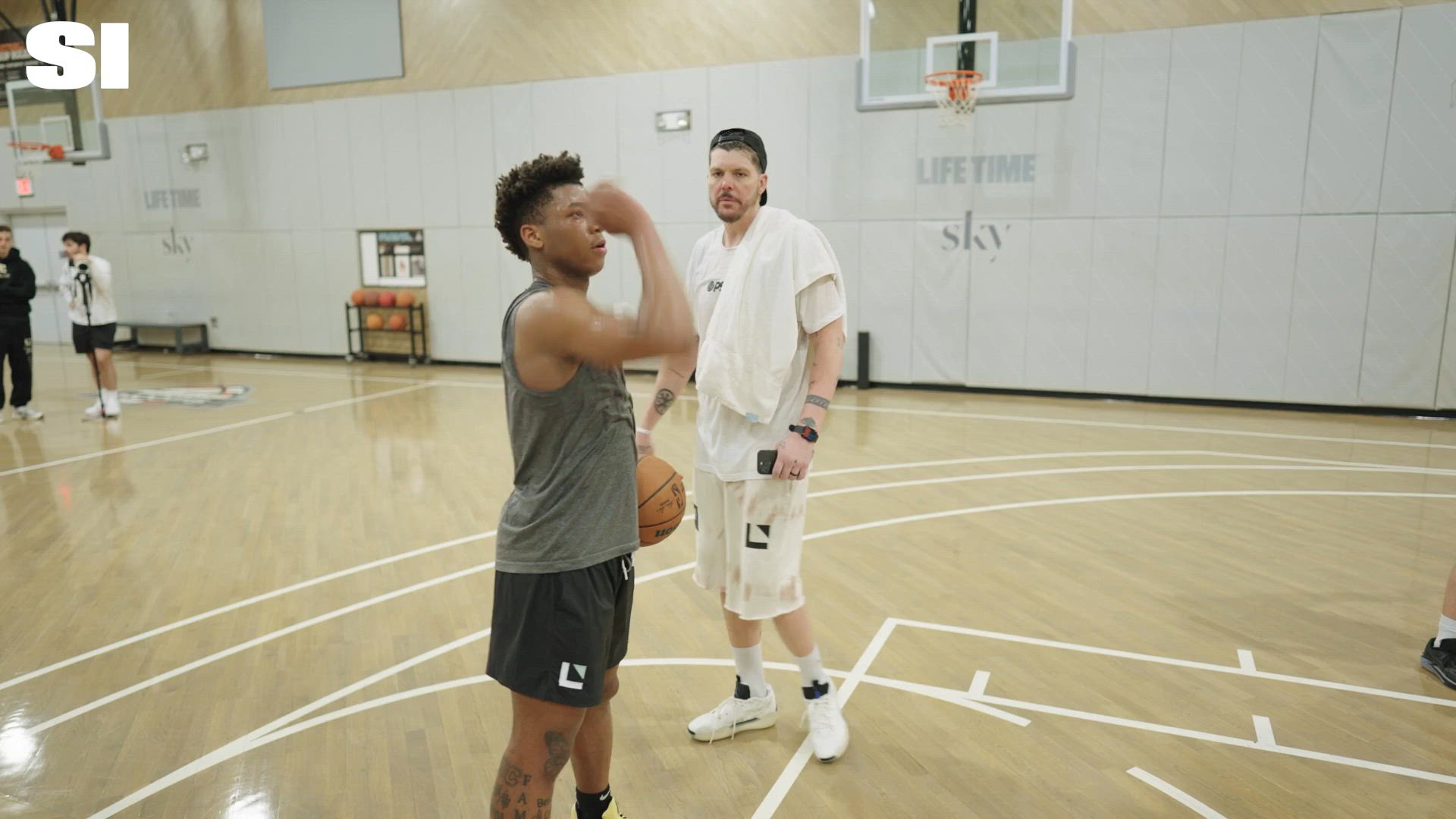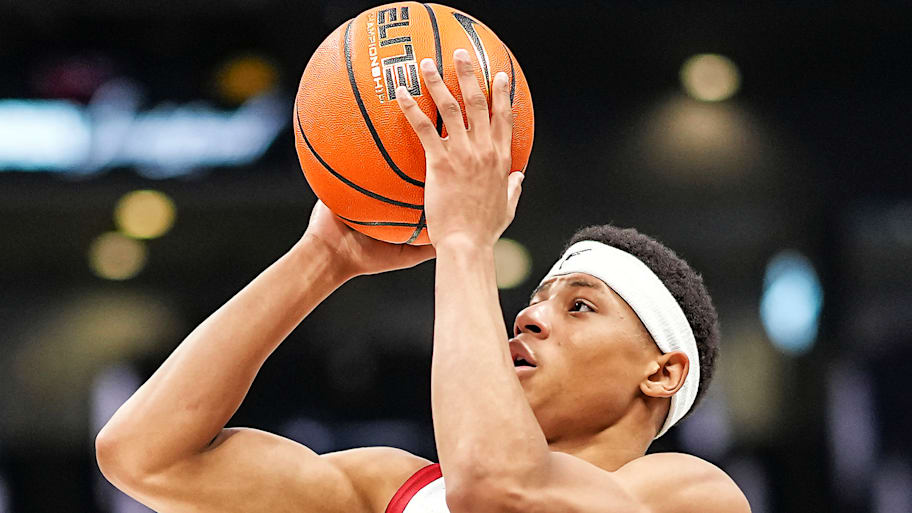Jeremiah Fears walked into basketball camp at Joliet West High School in 2021 standing just a bit over 5' 6" and weighing 126 pounds, with an Odell Beckham Jr.–style golden mohawk that made even the smallest player in the gym stand out in the crowd. Fears was well-known by Joliet West coach Jeremy Kreiger, who had played with Fears’s father, Jeremy, in high school. However, he came in as something of an unknown commodity to the older players on the team, who were naturally skeptical of the tiny rising freshman who hadn’t played in eighth grade due to the COVID-19 pandemic.
That first day of camp, Kreiger gathered the team and asked a simple question: Who’s the best player in the gym? Most picked one of the team’s senior stars, the obvious choice. Fears picked himself.
Some might’ve seen a comment like that as arrogance, and Kreiger admits it rubbed a few teammates the wrong way. But Fears quickly earned their respect with game and work ethic.
“He had an irrational confidence to believe he was the best player, but then he would go out and compete and show you why he was the best,” Kreiger says. “And it might not have been because of made shots or his handle or anything like that. It was because he was going to fight to not lose a drill or lose a scrimmage. And if he did, he was going to come back and fight harder the next time to not lose.”

The story is a strong synopsis of where Wednesday’s expected top-10 NBA draft pick comes from and where the 18-year-old who still operates with that “little brother” chip on the shoulder might be headed in his pro career. Fears has spent his entire life pushing the bounds of what a player his age can handle. At every turn, he has found a way to win anyway. The next task to tackle: NBA stardom, a lofty goal but one he’s not running from.
“Whenever teams ask me or whenever people ask me what I can bring to the team, I always mention star power,” Fears says.
And he’s not wasting time, either.
How quickly do you believe you can be a star in the NBA?
“Right away.”
A basketball has been in Jeremiah Fears’s hands since not long after he started walking. His father played professionally overseas in several European countries, and Jeremiah was along for the ride. At 2 and 3 years old, Jeremiah would put on his dad’s headband around the house and watch highlights of his games on YouTube. At 4 and 5, he’d tag along to the gym for his dad’s workouts to hoist shots at the hoop.
“He was always trying to shoot three-pointers,” Jeremy Fears Sr. says. “He couldn’t even reach the rim, but he wanted to shoot from behind the arc. I knew Jeremiah was going to play basketball at the youngest [age] ... he had a real crazy love for the game.”
With Jeremiah and older brother Jeremy Jr. (now a point guard at Michigan State) starting school, Jeremy Sr. decided to call it quits on his pro career and move back to the United States. He then channeled his energy into raising the boys, quickly watching them develop into quite the duo. Jeremy Jr. is 18 months older and two years ahead of Jeremiah in school, but Jeremiah says he almost always played up two age groups on teams with his brother … who was sometimes playing up a year himself. On those youth teams, Jeremiah concedes he was the Robin to Jeremy’s Batman, playing more as a scoring guard off the ball and letting his older brother run the point.
“He’s older, so he gets to call the shots, call first dibs on everything,” Jeremiah says.
In the backyard, however, Jeremiah wasn’t taking a backseat in the heated one-on-one showdowns with Jeremy Jr. Their father jokes the two rarely, if ever, finished a game without ending tangled up in some sort of shoving or wrestling match that ended things early. The two were neck-and-neck as younger kids. Jeremy Jr. hit his growth spurt first and handled Jeremiah during his middle school years, but Jeremiah says he finally beat him as a freshman in high school and has shut down the games since.
“I’ll never forget that [win],” Jeremiah says. “Ever since then, we haven’t really played. … I’m pretty sure he wants to play again, but I don’t think I want to play again. I think I’m going to just ride it out with my W.”
Those one-on-one clashes were part of how Jeremiah built a work ethic that coaches from every level of his journey rave about. Even as a fifth grader, he spent his summers itching for more time in the gym, often making multiple trips a day. His dad tells a story of Jeremiah calling him in tears one day when he was in sixth or seventh grade because his mom couldn’t take him to the gym, complaining the missed day would derail his dream of getting a scholarship to Kentucky. Jeremy Sr. eventually sent an Uber to pick Jeremiah up and take him to work out.
“When I say he earned this and he worked his way into it, that’s what I mean,” Jeremy Sr. says. “Like, it is insane when it comes to his work ethic.”

Fears backed up those confident words from that first day of varsity camp, earning the starting point guard job as a freshman. In his first game, against Missouri powerhouse Vashon High School, he scored 17 points and Kreiger put the ball in his hands for the last shot. He missed, but the gesture set the tone for an outstanding high school career. In his first two years of high school at Joliet West, his team went 28–4 in conference games, and he emerged quickly as a star, garnering early offers from a number of high-major colleges. After his sophomore year, he transferred to prep powerhouse AZ Compass for his junior year in 2023–24 to push himself more than the competition he was facing in the suburban Chicago high school scene. Fears led Compass in scoring, playing against competition like Cooper Flagg’s Montverde Academy team and other top national prep programs. He also kept playing up in the summers, competing at the 17U level of AAU for all three years instead of the 15U and 16U competition that most take on.
But the most daring move came last summer, when he announced in July his plans to graduate high school a year early and head to college in the fall despite not turning 18 until a few weeks before the season. Fears had been committed to play at Illinois in the 2025 class, but didn’t want to wait that long, and Illinois had brought in a crowded backcourt that spring that included another likely 2025 lottery pick in Kasparas Jakučionis. More opportunity existed at Oklahoma, where Porter Moser’s team desperately needed a late talent injection as it looked to get over the hump and reach the NCAA tournament for the first time in Moser’s tenure.
Was there risk involved? Sure. Fears would be one of the youngest players in the country, and after reclassifying in 2024, wasn’t even ranked as a top-50 player in his class, per 247 Sports. The track record for these late-summer reclassifications, especially with point guards, wasn’t pretty. But that was a worthwhile roll of the dice for the Sooners, and most importantly, it gave Fears a chance to fast-track his NBA aspirations and go to a situation where he knew he’d have a chance to play a lot. However unlikely the marriage was just a few months before, it turned into exactly what both sides needed.
“I think the cool thing was that Fears bought into, Let’s help you be one-and-done, simultaneously as us winning and getting the tournament,” Oklahoma assistant Clayton Custer, an accomplished point guard himself from Loyola Chicago’s 2018 Final Four team under Moser, says. “Fears wanted to win, too, and so we kinda laid out a plan and everything went exactly as we talked about the recruiting process.”
Just like that first day at varsity camp, Fears had to be comfortable being the youngest person in the room. He was walking into one of the oldest teams in the country, with its oldest player (guard Brycen Goodine) seven years and a few weeks older than Fears. Four other players turned 23 by the end of the season. Showing up to campus after a full summer of practices as the 17-year-old hotshot wasn’t easy, though Fears credits the veteran Sooners for welcoming him with open arms.
“I remember, when I first got there, we had an open gym and I had made a couple shots, made a couple of the right plays, and my teammates were all just really excited for me,” Fears says. “And I think that went a long way for me. It kind of just helped the overall process and built our chemistry from there.”
Fears came off the bench for his first three college games, all against inferior competition. But before the team’s trip to the Bahamas for its first big tests of the season, the Sooners inserted him into the starting lineup. He dropped 20 points against Providence on just eight shots, then turned around the next day in a high-profile showdown with a ranked Arizona team and outdueled one of the best guards in the country in Caleb Love. The final line: 26 points, five rebounds and five assists in an upset win that put Oklahoma on the national radar and made Fears’s one-and-done chances look a lot more real.
“The dude, for lack of a better way of saying it, is just not scared of anyone,” Custer says. “Arizona is the best team he has played in his college career and he’s not even worried about the game, he’s just locked in and ready to go … he literally had no fear. He thought he was the best player on the court no matter who we were playing against.”
The hype about Fears and the Sooners reached a crescendo in mid-December, when Fears dropped 30 points on Michigan, including a game-winning four-point play in the final seconds, in a nationally televised (and heavily scouted) game. Six months after he was playing in summer AAU tournaments, Fears was all of a sudden one of the most talked-about NBA draft prospects in the country and leading an undefeated team into SEC play.
But in league play, Fears was quickly humbled. Oklahoma started 0–4 and lost 10 of its first 13 SEC games. A season that started so promising was on thin ice, and Fears was struggling in the process. Georgia held him to two points on 1-of-11 shooting in a 10-point loss. Texas A&M held him scoreless. Murmurings about Fears hitting the proverbial “freshman wall” began. Oklahoma, once knocking on the door of the top 10, was on the verge of missing the NCAA tournament altogether.
“Every freshman hits that wall where they might have a couple bad games or they made a couple bad decisions late in the game,” Fears says. “[The coaches] just told me to keep going. And I think I did a great job with that, just looking forward, looking at the positive through every basketball situation.”
And Fears’s response to that adversity may have been the most impressive part of his freshman year. Missouri held him to just eight points on 3-of-13 shooting in a 24-point loss on Feb. 12. Three weeks later, Fears turned around and torched them for 31 points in what was essentially a must-win for the Sooners. Remember that 1-of-11 showing against Georgia? In the second meeting, a conference tournament game that was essentially a win-and-in game for Oklahoma’s NCAA tournament hopes, Fears ripped off 29 points and was the best player on the floor.

“He has a natural curiosity on the floor,” Custer says. “He’s not scared to test things out a little bit, and I think the first time through conference play, maybe they got him a couple times, but I think it also helped him learn against different coverages what works. The second time we came back and played [SEC teams], he dominated the game.”
“It’s what the great ones need: a mental resiliency to not be fragile,” Kreiger says. “There’s a difference between failing and failure, and Jeremiah’s always in the process of failing because he knows you need to do that to be better.”
Amazingly, he put together his sparkling campaign at Oklahoma despite struggling from three. He shot just 28% from distance on the season and 23% during SEC play. It didn’t hinder his effectiveness much in college, but if NBA teams don’t have to respect him from beyond the arc, Fears’s explosiveness as a ballhandler gets neutralized. It’s a puzzling twist for a player who until a year or two ago had always been known as a sharpshooter. As an undersized scoring guard growing up, his range was an essential part of his game. His shooting struggles have coincided with his late growth spurt and plenty of added muscle in the weight room. Get the shot right, and Fears becomes as compelling as any prospect not named Cooper Flagg in this class.
“Him growing up, like, you couldn’t allow him to shoot. Twenty-five feet and in, from sixth grade on, you were playing with fire,” Kreiger says. “If Jeremiah Fears turns into the shooter he used to be … it’s going to be very hard to keep him contained.”
Just as he has in high school and college, Fears will walk into whichever NBA organization that drafts him (likely in the first eight picks), likely as the youngest and potentially the smallest person on the floor. His electrifying game has won over everyone in the room quickly in those previous stops, and he believes it will be no different even against the best competition in the world.
“The Oklahoma team, a lot of people really didn’t expect me to kind of do what I did, but I had the self-confidence in myself and trust in my work,” Fears says. “I know what I can bring to a team.”
There may not be a player in this class, especially among the high-lottery picks that Fears will likely end up selected in, who has transformed his stock in the span of a year the way Fears has. That bet on himself to head to college early, however risky it was, has paid off in droves.
“I thought about [the NBA] every day,” Fears says. “I knew what I was working towards.”
That irrational confidence from day one of high school basketball? It doesn’t look so irrational anymore. And after proving it at every level including the toughest conference in college basketball, it’d be foolish to bet against Jeremiah Fears fulfilling his aspirations of stardom.
More NBA draft on Sports Illustrated
This article was originally published on www.si.com as Jeremiah Fears Rises From Underrated High School Recruit to Top Draft Projection.
